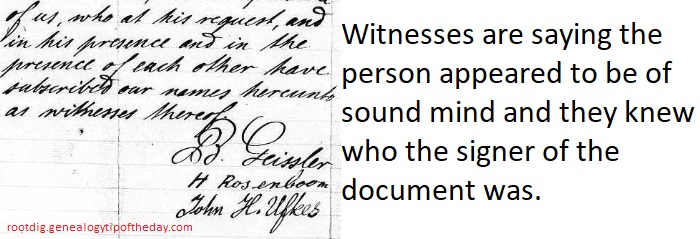
Witnesses to a document can confuse some genealogists.
Witnesses are simply saying that they saw the individual who was actually signing (and executing) the document sign the document and that the person signing the document was the person they were purporting to be and that they were able to execute such a document.
Witnesses usually needed to be of legal age to witness a document and generally could not be interested in the document–eg. beneficiaries in a will could not be witnesses.
Witnesses do not have to be related. They could be, but it was not necessary.
I’ve wondered in a few cases if when my recently arrived immigrant ancestor needed to sign a document they had witnesses who were other immigrants that they knew who could read English better than they could.
In the illustration, the testator was a Ostfriesen immigrant. One witness (Geissler) was local pastor. Another witness (Ufkes) was a fellow immigrant from the same village who had known the testator since they were children. The other witness (Rosenboom) was a fellow immigrant.
Witnesses can be clues and they could be associates of your ancestor who were there to make certain the document was drawn up correctly.
But they can also be warm bodies who were “in the office” the same day your ancestor went to have something drawn up.

No responses yet